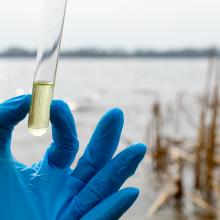Case Studies, Environmental, Academic
/ Organomation
Students at Southern Illinois University, Edwardsville, are leveraging an Organomation 24-position N-EVAP to evaluate the efficiency of different wastewater treatment systems in removing antibiotics. Given the rising concern over antibiotic-resistant bacteria due to pharmaceutical contaminants, this research focuses on analyzing the therapeutic and agricultural antibiotics prevalent in wastewater.
Using Solid Phase Extraction (SPE) and Liquid Chromatography with Tandem Mass Spectrometry (LCMS/MS), the team measures antibiotic concentrations across various treatment methods, including Membrane Bioreactors (MBR) and primary aeration systems. The SPE eluent is evaporated to dryness using ultra-high purity nitrogen gas in the N-EVAP evaporator, followed by centrifugation and LCMS analysis.
Why Evaporation to Dryness?
Evaporation to dryness is a common and effective sample preparation method for LCMS due to several key reasons:
1. Concentration of Analytes: By removing the solvent, analytes are concentrated, enhancing the detection sensitivity of the LCMS.
2. Solvent Compatibility: It ensures that the final solvent is compatible with the LCMS, preventing issues like ion suppression or poor chromatographic behavior.
3. Removal of Interfering Compounds: It helps in eliminating non-volatile impurities that might interfere with the analysis, leading to more accurate results.
4. Sample Preservation: Dry samples are more stable and easier to store or transport, maintaining the integrity of the analytes until analysis.
Discover: Evaporation to Dryness Through Nitrogen Blowdown
Why LCMS/MS?
LCMS/MS was the ideal analytical method for this project for several reasons:
1. High Sensitivity and Specificity: LCMS/MS provides the sensitivity needed to detect low concentrations of antibiotics in complex wastewater matrices.
2. Quantitative Accuracy: It allows for precise quantification of multiple antibiotics simultaneously, providing detailed insights into their concentrations and removal efficiencies.
3. Robustness and Reliability: LCMS/MS is highly highly robust, making it suitable for repeated measurements and long-term studies without significant performance degradation.
4. Versatility: It can handle a wide range of antibiotics with varying chemical properties, making it a comprehensive tool for environmental analysis.
The findings revealed that MBR systems were highly efficient, achieving up to 99% antibiotic removal, crucial for mitigating the ecological risks posed by wastewater. This research not only underscores the importance of advanced wastewater treatment but also paves the way for further studies on antibiotic resistance in aquatic environments.
For more information, view the poster presentation, “Detection and Quantification of Antibiotics in Various Wastewater Treatment Systems using LCMS.”
The Preferred Evaporator for Academic Research
The N-EVAP is the preferred nitrogen blowdown evaporator among universities due to its high efficiency, flexibility, and reliability in sample preparation. Its ability to consistently concentrate analytes and remove impurities ensures high-quality results, making it an invaluable tool for academic research in environmental analysis and beyond.
(Edited 8/14/24)
